-
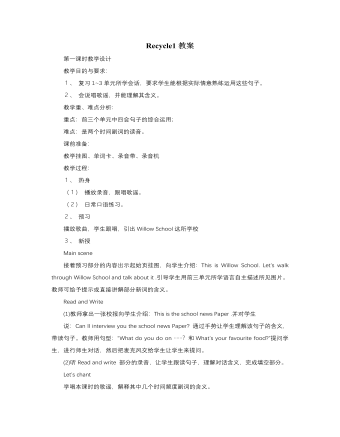
人教版新课标PEP小学英语五年级上册Recycle1教案
巩固延伸尝试与他人进行书信交流第三课时教学设计教学目的与要求:1、 能够使用所学四会句子完成Task time中的采访任务。2、 能够理解Let’s play中的问题并做出正确回答。3、 能够听懂、会唱歌曲“My Favourite Day”。教学重、难点:重点、难点为复习并使用四会句子完成Task time中的采访任务,并展示个人报道。课前准备:教学挂图、录音带、录音机、简历表教学过程:1、 热身(1) 放第二单元歌曲,学生跟唱,复习有关一周七天的单词。(2) 日常口语练习。2、 预习:放录音,欣赏歌曲。3、 新授Task time(1) 就歌曲内容向学生提问:Do you like weekends? What’s your favourite day? 引导学生回答:My favourite day is Saturday/Sunday. 并请学生说明理由,表述周末活动。出示采访表,回答问题。(2) 让学生参照学生用书的采访表进行小组交流,并在最短的时间内填充表格,然后每组派代表做汇报。Let’s play看图片,指导学生先读懂句子,再回答问题。Let’s sing学生理解并学唱本单元歌曲“My Favourite Day”.巩固延伸:采访教师;画画猜人
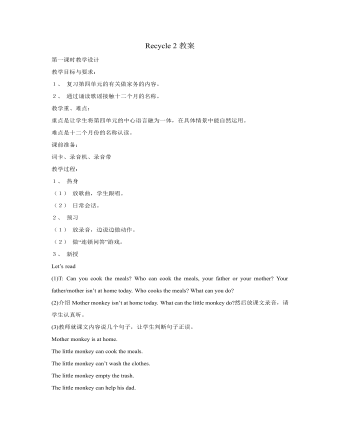
人教版新课标PEP小学英语五年级上册Recycle2教案
教学目标与要求:1、 通过活动和复习句型,介绍及动作短语等。2、 学唱歌曲。教学重、难点:重点为复习巩固介词及存在句型。难点为正确区分内容相近的图片。课前准备:词卡、录音机、录音带、图片教学过程:1、 热身(1) 放歌曲录音,学生跟唱。(2) 师生进行日常会话。2、 预习做“按我说的做”游戏。3、 新授(1) 看图片,问:Where is the …? Ss: It’s in /on/over…(2) 做“猜一猜”游戏。(3) 两人一组完成Pair work,连一连,说一说。(4) 听录音,完成练习。录音原文如下:There are mountains behind her village. There is a river near her house. There is a new air-conditioner in her bedroom. She cleans her bedroom every day.There is a lake near his village. There are many trees in front of his house. There is a big trash bin in his kitchen. He can cook tasty meals.There is a forest near his village. There is a road beside his house. There is a man under a tree. He often waters the flowers.There are many Paths in her village. There are new curtains on the window of her house. There are many new skirts in her closet. She washes the clothes every weekend.巩固延伸:做“幸运摸奖”游戏
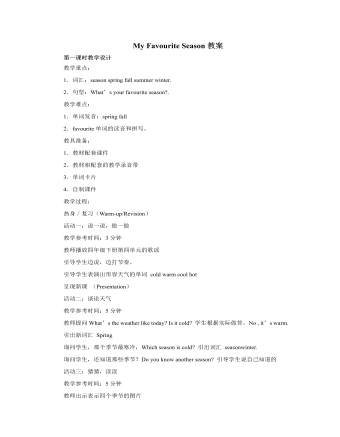
人教版新课标PEP小学英语五年级下册My Favourite Season教案
(三)趣味操练 (Practice)活动六:猜一猜教学参考时间:5教师说:Guess what’s my favourite season. Why?学生猜测:It’s winter. Because you can skate. 教师给予肯定或否定的答案然后邀请另一名孩子起来,大家继续猜测活动七:传话游戏教学参考时间:3分钟教师在每个小组第一个同学耳边轻声说一个句子:I like summer, because I can swim./I like fall, because I can find many beautiful defoliation.(落叶)/….每个小组传话,看谁传的又快又好每组的最后一个汇报你听到的句子(四)巩固和扩展(Consolidation and extension)活动八:Link and say教学参考时间:5分钟完成活动手册P13—3两人一小组,分别说说每组图代表的季节,服装,和事情教师提问,What would you like to do in spring/in summer/in winter/ in fall?,请孩子回答。两人一组问答,根据你听到的连出出对方喜欢的季节事情两个人交换书对答案活动九:Let’s do a survey 教学参考时间:5分钟完成活动手册P13—4自己认读范例对话,明确题意小组调查(6人)各小组展示答案活动十:试一试(Let’s try)教学参考时间:5分钟教师播放录音,学生理解再听录音,选择你听到的图
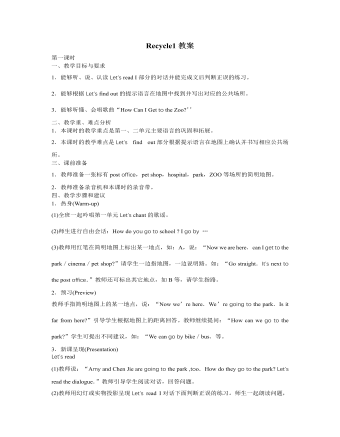
人教版新课标PEP小学英语六年级上册Recycle1教案
1.热身(warm-up) (1)全班齐唱歌曲“How call I Get to the Zoo?’’ (2)师生一起吟唱第一单元的歌谣,要求学生一边吟唱,一边用手打节拍。 2.预习(Preview) 教师对学生有关My Dream Vacation的短文做出总体评价,并请几名写得有创意的学生朗读他们的短文,教师针对其内容提问,如:“Where are you going? What are you going to do? How are you going to there等。教师根据课前的准备,在最后一名学生朗读完文章并回答了问题以后,简化并板书该学生的回答,将其改编成为一首小歌谣,如: Where are you going? What are you going to do? I’m going to the ZOO to see the monkeys. I’m going by bike.I’m going On foot. I live near the ZOO.So I won’t take a train. 教师拍节拍示范朗读自己改写的新歌谣,学生模仿吟唱新歌谣。 3.新课呈现(Presentation) Let’s chant 在以上活动的基础上,教师放Let’s chant部分的录音,学生静听并试着跟读,再看着文字吟唱。师生可进行问答式吟唱,并在小组间展开比赛。 Listen and match
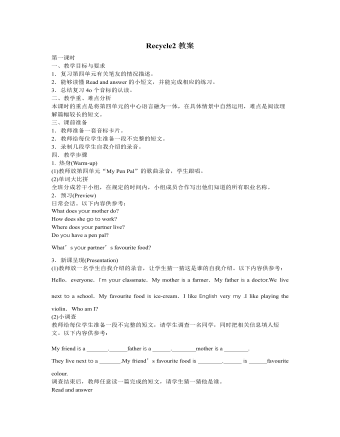
人教版新课标PEP小学英语六年级上册Recycle2教案
2.预习(Preview) 看字母,说职业 教师出示职业名称单词的首字母,让学生说出整个单词。如:w-writer;d-driver/doctor,a-accountant/actor/actress;T-TV reporter等o 3.新课呈现(Presentation) (1)从看字母说职业名称引出TV reporter,教师拿出一些名人照片说:“Now you’re a TV reporter.You’re going to interview a famous person.You don’t know who he/she is .But you know he/she is someone in the pictures.”给学生五次提问的机会,让他们根据教师的回答找出正确的人物。以下问题供参考: What does he/she do? What’s h is hobby ? Is he strong/thin/tall? Where does he/she live? (2)心有灵犀 请两名学生(sl和s2)上来,每人拿着纸和笔分别站在教室的两边。教师提问:“What does s1’s father do?”站在台上的两名学生分别把答案写在各自的纸上。如果两人的答案完全相同,两人就算获胜。教师继续问问题“What does …’s…do?”全体学生一起写出答案,谁写的答案正确就可以得一分。 Listen and match (1)教师说:“Do you want to know more about Liu Yun?’’学生回答后教师说:“Please listen and find out.’’教师放本部分录音,学生认真听。
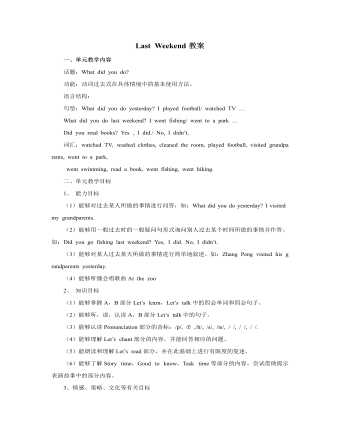
人教版新课标PEP小学英语六年级下册Last Weekend教案
一、教学内容:Part B Let’s learn Let’s play. Part C Task time Let’s check 二、教学目标与要求 1、掌握四会词组:went to a park, went swimming, read a book, went fishing, went hiking. 2、学会用句型What did you/ (name) do last weekend/ yesterday? I(name) (did) last weekend/ yesterday. Did you….? Yes, I did. 来进行问答并完成Task time的表格。 三、教学重点 掌握四会词组,并用所学词组和句型进行调查 四、教学难点 掌握四会词组(不规则动词过去式变化),并用所学词组和句型进行调查 五、课前准备 1、教师准备所需的词卡及图片。 2、学生准备词卡。 六、教学过程 1、Warm-up 1) Free-talk: T: What day is today? A: Today is… T: What day was yesterday? (强调 yesterday) B: Yesterday/ It was… T: What did you do yesterday? C: I (did)…yesterday. ( 用前几课时已经学的词组) 2) Chain-drill: C: I (did)…yesterday. What did you do yesterday? D: I (did)…yesterday. What did you do yesterday? E, F… (ask the teacher) T: I went to a park yesterday. 2、Presentation and practice let’s learn (1)继续Chain-drill,由T 引出并出示新授词组:went hiking. (2)学生已经了解了go 的过去式后, T 边用I went ( 这个动词用动作表示)yesterday.表达自己昨天去做什么了,边做动作.让学生帮老师说出: went swimming, went fishing.
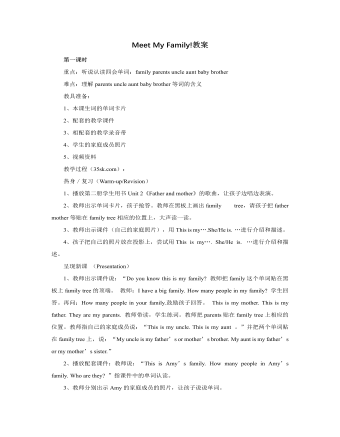
人教版新课标PEP小学英语四年级上册Meet My Family!教案
教案点评: 本课时在上一课时的基础上,进一步在情景中学习句型Is this your...? He/She looks... What’s he/she? They look... Are they...? 本课时的内容和学生的实际生活贴近,学生对该话题感到亲切,教学新句型时教师运用学生的家庭照片,在师生的对话中自然的呈现新知和操练句型,有助于学生更好的掌握和操练对话。本堂课教学层次分明,教师引导适当,发挥了学生在学习中的主体地位第六课时重点:单词nurse, doctor, farmer, driver的拼写。难点:I’m going to be a…教具准备:1.图片nurse, doctor, farmer, driver2.教材相配套的教学录音带3.单词卡片教学过程(35sk.com):一 热身/复习(Warm-up/Revision)1.口语练习:How many people are there in your family?Who are they?What are they?2.让学生改编B部分的chant, 然后表演出来。教师对表现出色的应即使给予奖励。二 呈现新课 (Presentation)1.教师出示表示表职业的单词卡让学生认读,并贴在黑板上。2.做找朋友的游戏。让学生把图片贴到相应的单词下。
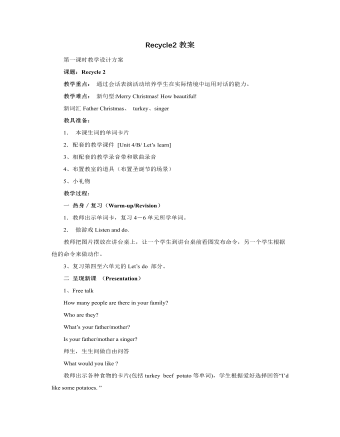
人教版新课标PEP小学英语四年级上册Recycle2教案
二 呈现新课 (Presentation) 1、pass the word 两个小组听音乐同时向后传词卡,一组传成员,一组传职业。音乐停后,拿成员的学生问另一人,如:“What’s your father? My father is a doctor.” 2、group work 两人一小组,互问答,学生根据对方的回答摆词卡。 根据卡片,用句子描述一下自己的家庭成员和职业。(仿照歌谣中的句型) 3、Listen and match 听一听Chant,请孩子们根据录音摆一摆卡片。一个学生在黑板上摆。 4、观看课件,边看边跟读。看书,边看边指书中的人物。 5、听录音,边听边打节奏。男女生接龙说歌谣。各小组接龙说歌谣。请几个学生接龙说歌谣。6、各小组说一说,演一演歌谣。各小组展示歌谣。 7、教师出示一个制作好的圣诞礼物,说:“Do you like it?”“Today let’s make a gift ,ok?”教师边说边示范制作过程。学生认真听,理解。
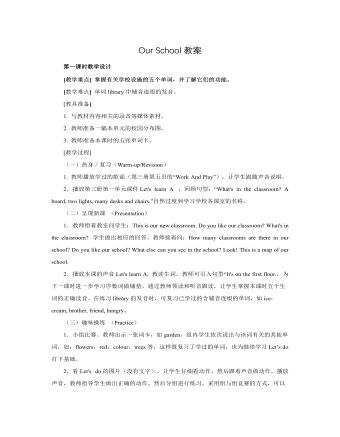
人教版新课标PEP小学英语四年级下册Our School教案
教学重点:Read and write 中的四个四会单词以及问句“Is this a teacher’s desk?”及其答句“Yes, it is.”在四线格中的正确书写。教学难点:拼读单词picture,在四线格中书写句型“Is this a …?”以及总结元音字母a的发音规则。教具准备:1.与教材内容相关的课件、声音、图片等媒体素材。2.教师准备相关的词卡。3.学生准备白纸和彩笔。教学过程(35sk. c om整理):(一)热身/复习(Warm-up/Revision)1.师生合唱该单元的歌曲和歌谣,边歌边舞。2.请学生表演Story time中的对话。3.猜谜语:教师给学生出一些简单的谜语,如:Jack is in a room. There are many books in it. He can see many students. They are reading books. They are quiet. Where is Jack?(二)呈现新课 (Presentation)1.请学生观察Read and write部分的情景图,预先空出来需要书写的四会单词,让学生独立思考,填充对话。
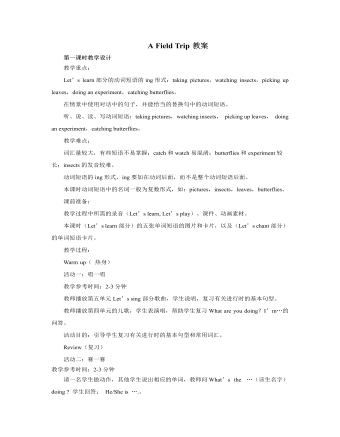
人教版新课标PEP小学英语五年级下册A Field Trip教案
活动八:Story time:教学参考时间:5-7分钟打开书,学生自己阅读故事。两人一小组,尝试初步朗读。小组间互相提问回答:一人问,另一人回答。有两个人都不明白的问题,向全班提问。教师提问:(如果这些问题已经被同学问过了就不用再问了。)Is Zoom reading a book?Is he fishing?Are the frogs playing in the river?Are they catching mosquitoes?What are the frogs doing?教师播放故事录音,学生跟读。教师启发学生说一说从故事中学到了什么。教师要适时告诉学生青蛙是人类的朋友,要爱护青蛙。活动目的:Story time的教学,是培养学生阅读能力的有效载体,教师应充分利用。教师要给孩子充分的时间让孩子能够实实在在的进行阅读,从阅读中获得信息。经过了两年的学习,学生应该具备了初步的阅读小故事的方法,因此教师可以引导有能力的学生在原有的基础上,运用已经学过的语言,对故事进行简单的复述。这样做一方面可以检查学生理解的程度,另一方面可以进一步培养、锻炼学生的语言表达能力。
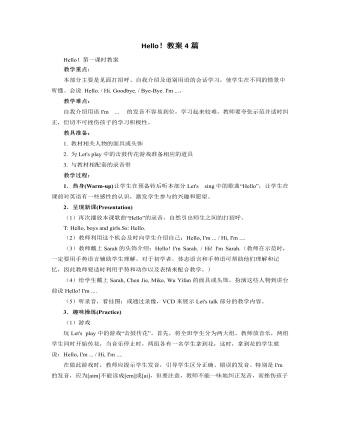
人教版新课标PEP小学英语三年级上册Hello!教案4篇
(3)通过游戏Simon says 来练习以show, open, close, put, carry 所引导的祈使句。教师发指令学生做动作。但只有听到老师带有Simon says的指令时,才能做出相应的动作,否则就是失败。失败的同学退出游戏。(4)听Let's chant的录音,学生边听边做,逐渐过渡成边听边说边做,最后独立说做,并进行比赛。4. 课堂评价(Assessment)做活动手册本单元第5部分练习。学生根据录音,圈出所听到的文具。具体方法和步骤参考如下:(1)学生看图,用英语说出图中每样文具物品。(2)教师讲解题目的意思并指导做的方法。(3)学生听录音做练习。(4)再放录音,在教师的指导下让学生一句一句地跟读并互相核对答案,并说出所圈的文具,再通过给花朵涂色进行自我评价。5. 扩展性活动(Extensive activities)选词游戏。将学生分为六组,每组各派一个选手,教师说单词,选手快步跑到讲台前,找到所说单词,并举起大声读出,正确为胜。
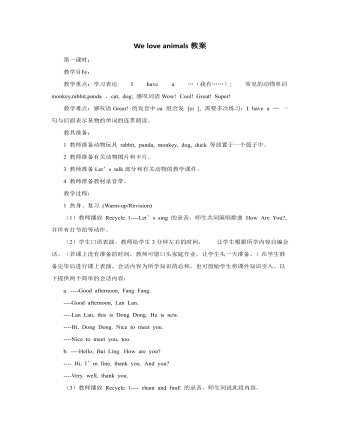
人教版新课标PEP小学英语三年级上册We love animals教案
(1)游戏:向它那儿跑去(Run to it!)首先,用图片和词卡练习本课的6个新单词。学生边读老师边把卡片贴在黑板上。将全班分成两队。给学生下一个Run to the bird.这样的指令。每队的第一个学生向带有鸟的图卡和词卡的地方跑,并且用手摸一下这两张卡片。哪组学生先摸到卡片就给他们队得一分。教师也可以用本课刚学的指令:Walk to….Jump to ….Fly to….等指令学生用相同的动作走(跳,飞)到卡片前。(2)教师将Let’s do的图片打乱顺序,让学生听指令,选出正确的图片。(3)游戏:照我说的做(Do as I say)教师发指令,全班同学起立做动作。做错的同学随时坐下。最后,哪组站着的同学多,哪组获胜。教师参考指令: Climb like a monkey/bear.Jump like a squirrel/rabbit.Walk like an elephant/duck.Hunt like a mouse/pig.Act like a cat/dog.Fly like a bird.为了增加游戏的难度和趣味性,教师可逐渐加快指令的速度。4.课堂评价(Assessment)做活动手册本单元第5部分的练习。方法和步骤参考第一单元。
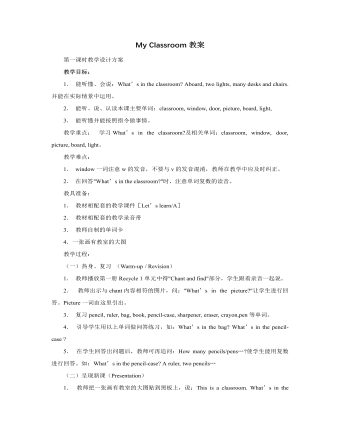
人教版新课标PEP小学英语四年级上册My Classroom教案
1、本单元要求会听,说,认读的单词: Window board light picture door floor classroom computer wall teacher’s desk fan what in the we have new go where2、本单元要求会听,说的单词和词组: Many our seat near classmate cleanhave a look good idea all right good job3、帮助学生在掌握单词的基础上造出句子,编出对话,学以致用。 4、培养学生用英语交流的能力,为学生的进一步学习奠定基础。 二、教学要求 1、能听懂、会说,会用每一课会话。 2、掌握本单元出现的生词,词组和字母。 3、会唱本单元的歌曲。 三、教学重点和难点 1、对于较长的单词如classroom, classmate, computer的掌握以及对于第一次出现的词组和短语如have a look, good job的掌握。2、对于礼貌用语“Thank you , Excuse me, After you”的掌握与应用。 3、描述教室中所有物件,并能据此编出对话。 四、教学时间 本单元共6课时,每周3课时,2周完成。 Lesson 1 1.Teaching Aims Let the students master the words: window, classroom, floor, light, door, board, and picture. When they see the objects, they can recognize and read them and do the action about them.
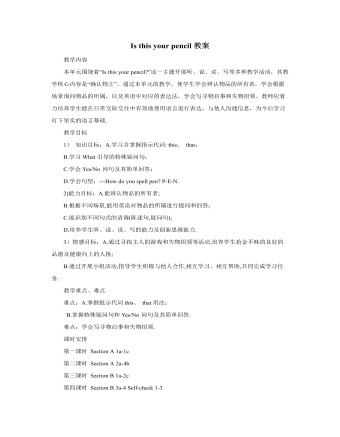
人教版新目标初中英语七年级上册Is this your pencil教案
T: Please look at the pictures and learn the new words.(用多媒体展示新单词效果较好。)1.at prep. 在(里面或附近);在(点刻);2.theart.表示特指的人、物、事或群体 3.lostadj.丢失的;遗失的4.Found adj. (find的过去式、过去分词)找回的5.lost and found 失物招领6.please adv.请7.school n. 学校8.a set of一套;一副(Teach students to read the words.)2. Practice the new words. (事先录制一段短的听力,让学生通过听的训练来强化所学的新单词,并为学习写寻物启示和失物招领作好准备。)T: Please listen to a short passage twice then fill the blanks using the words we learned.(Show students a short passage and play the recording for the students to listen.)There are many things in (1)_____________________in my (2)__________. Look, here’s (3)_________keys. Is this yours? (4)__________call Jim (5)___________753-2289.Typescript:There are many things in the Lost and Found in my school. Look, here’s a set of keys. Is this yours? Please call Jim at 753-2289.
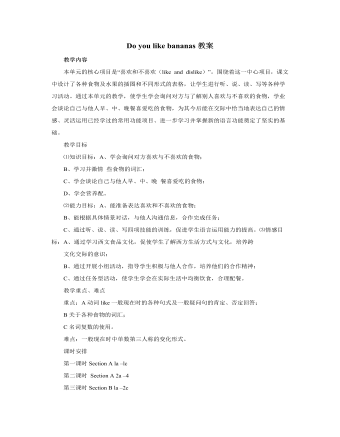
人教版新目标初中英语七年级上册Do you like bananas教案
教学目标 ⑴知识目标:A、学会询问对方喜欢与不喜欢的食物; B、学习并激情 些食物的词汇; C、学会谈论自己与他人早、中、晚 餐喜爱吃的食物; D、学会营养配。 ⑵能力目标:A、能准备表达喜欢和不喜欢的食物; B、能根据具体情景对话,与他人沟通信息,合作完成任务; C、通过听、说、读、写四项技能的训练,促进学生语言运用能力的提高。⑶情感目标:A、通过学习西文食品文化,促使学生了解西方生活方式与文化,培养跨 文化交际的意识; B、通过开展小组活动,指导学生积极与他人合作,培养他们的合作精神; C、通过任务型活动,使学生学会在实际生活中均衡饮食,合理配餐。 教学重点、难点 重点:A动词like一般现在时的各种句式及一般疑问句的肯定、否定回答; B关于各种食物的词汇; C名词复数的使用。 难点:一般现在时中单数第三人称的变化形式。
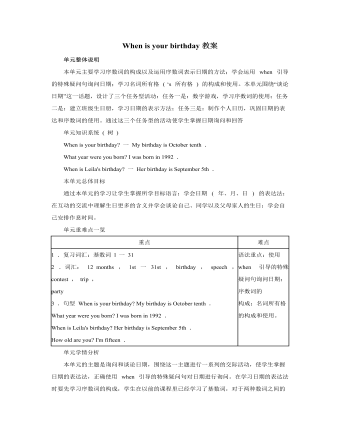
人教版新目标初中英语七年级上册When is your birthday教案
本单元主要学习名词所有格 ('s 所有格 ) 的构成和使用。在初次接触 “ 名词所有格 ” 时,学生较难理解的可能是 “ 所有格 ” 这个名称,对于它的构成,学生也许会觉得较容易。教师可通俗地告诉学生 “ 所有格 ” 的意思是表示 “…… 的 ” ,这样学生反而容易接受。在使用 “ 名词所有格 ” 形式时,学生容易犯错误或混淆的主要是:将这种一 's 构成形式与 is 的缩写形式混淆,如: My father's name's Jin Zhi .,可以这样告诉学生:名词所有格的后面一般应接名词;勿将这种一 's 结构盲目套用与人称代词上,代替物主代词使用,如 He's father's name is Li Cheng 。在教学初期,可不讲授名词所有格的其它形式,待时机成熟,再向学生介绍复数名词所有格形式的结构一 ' ,如: the students' bikes 。 Self Check 教学内容 Self Check( 教材 P52) 教学目标 知识与能力 复习词汇 birthday , date , month , January , February , March , April , May , June , July , August , September , October , November , December , date , birth , age , old , speech . contest . trip , party , event , an , festival , pop , concert , chorus , lecture , music ;引导学生复习、巩固“询问和谈论日期”的目标语言并运用所学知识安排活动。
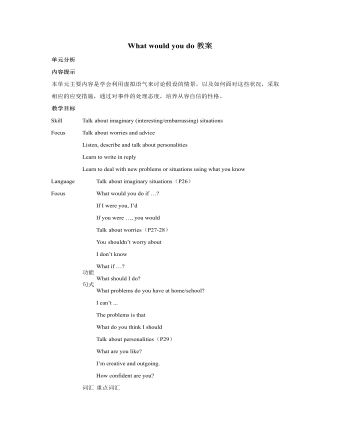
人教版新目标初中英语九年级上册What would you do教案
本课采用任务型教学法,用What would you do if you had a million dollars?这个问句,引出谈论假想情况的话题。 采用提问、启发和归纳的教法,让学生易于接受教材内容,培养学生的语言运用能力。 四、 教学过程设计 Step Ⅰ. Greet the whole class as usual. Step Ⅱ. Warming-up T: Do you have ten Yuan in your pocket? S1: No, I don’t. T: (Take out ten Yuan and give it to the student) OK, never mind. What would you do if it was yours? What would you do if you had ten Yuan? S1: I would buy snacks. T: OK, thank you. Sit down, please. (To the whole class) Just now, it was only ten Yuan. What about 100 Yuan? What would you doif you had 100 Yuan? S2: I’d buy a beautiful jacket. T: Thank you. (To the whole class) Now suppose you had a million dollars, what would you do? We know thatone dollar nearly equals eight Yuan, so that’s a large sum of money. Think it over carefully and tellme your ideas. What would you do if you had a million dollars? S3: I’d buy a big house. S4: I’d buy a sports car. S5: I’d put it in the bank. T: OK, stop here. Please look at the blackboard and guess what would I do if I had a million
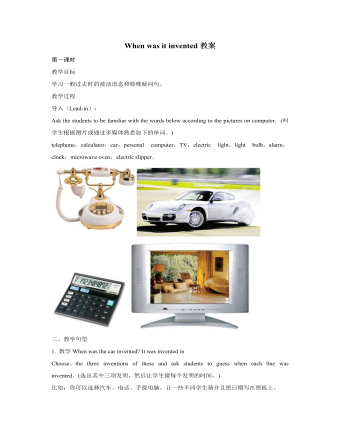
人教版新目标初中英语九年级下册When was it invented教案
二、教学 1a,1b.1.First the teacher asks the students what kind of fruit food and drink you like the best and writes down on the blackboard.教师问学生最喜欢什么水果和饮料并把它们写在黑板上。比如:potato chips,ice cream,tea,lemon,chocolate,oranges,salad,popcorn,pickle and so on.2.接着叫学生表达以上食物的味道,引出新单词——sweet,crispy,salty,sour,delicious,hot,awful,nice…并且完成lb教学内容通过此活动,以旧带新引入新单词。其目的是让学生自主学习新知识。 三、教学 2a,2b1.首先,听力前的brainstormFirst,Let students describe how potato chips taste and describe how helpful the potato chips.Then,ask:When and where were potato chips invented?Who were potato chips invented by?How were potato chips invented?(Let students guess according to the following key words.)Key words:by accident,customer,restaurant,by mistake.(说明:通过问题让学生对对话内容有整体了解,为听力练习做好准备;又培养学生的注意力,想像力,观察力。)
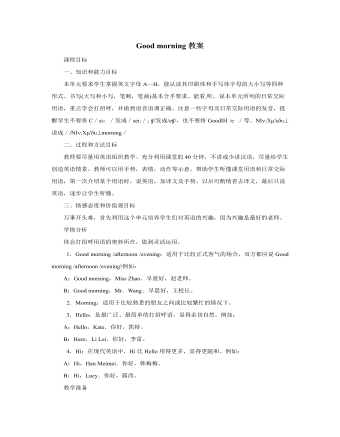
人教版新目标初中英语七年级上册Good morning教案
一、知识和能力目标本单元要求学生掌握英文字母A—H,能认读其印刷体和手写体字母的大小写等四种形式。书写(大写和小写,笔顺,笔画)基本合乎要求。能看,听,说本单元所列的日常交际用语,重点学会打招呼,并做到语音语调正确。注意一些字母及日常交际用语的发音,提醒学生不要将C/si:/发成/sei:/; ?/发成/e?/,也不要将Good?H /e /等。??????'????说成/???????'???morning/二、过程和方法目标教师要尽量用英语组织教学。充分利用课堂的40分钟,不讲或少讲汉语,尽量给学生创造英语情景。教师可以用手势,表情,动作等示意,帮助学生听懂课堂用语和日常交际用语,第一次介绍某个用语时,说英语,加译文及手势,以后可酌情省去译文,最后只说英语,逐步让学生听懂。
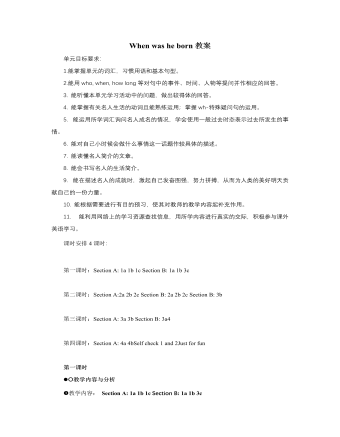
人教版新目标初中英语八年级上册When was he born教案
1.能掌握单元的词汇,习惯用语和基本句型。2.能用who, when, how long等对句中的事件、时间、人物等提问并作相应的回答。3. 能听懂本单元学习活动中的问题,做出较得体的回答。4. 能掌握有关名人生活的动词且能熟练运用;掌握wh-特殊疑问句的运用。5. 能运用所学词汇询问名人成名的情况,学会使用一般过去时态表示过去所发生的事情。 6. 能对自己小时候会做什么事情这一话题作较具体的描述。7. 能读懂名人简介的文章。8. 能会书写名人的生活简介。9. 能在描述名人的成就时,激起自己发奋图强,努力拼搏,从而为人类的美好明天贡献自己的一份力量。10. 能根据需要进行有目的预习,使其对教师的教学内容起补充作用。11. 能利用网络上的学习资源查找信息,用所学内容进行真实的交际,积极参与课外英语学习。课时安排4课时:第一课时:Section A: 1a 1b 1c Section B: 1a 1b 3c第二课时:Section A:2a 2b 2c Section B: 2a 2b 2c Section B: 3b

